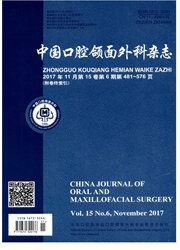

 中文摘要:
中文摘要:
目的:回顾分析导致颞下颌关节强直的成人髁突骨折类型。方法:回顾口腔外科关节组2010--2012年收治的由髁突骨折保守治疗导致颞下颌关节强直.从损伤到发生强直有完整CT资料的成人病例.按照下颌支残端与关节窝的位置关系,将髁突骨折分为3级,一级为下颌支残端位于关节窝内,与之无接触;1级为下颌支残端位于关节窝内.与之有接触;2级为下颌支残端外上方脱位出关节窝。结合髁突骨折类型、骨折块移位程度和关节盘的位置、下颌骨其他部位骨折情况等,分析关节强直形成的原因。结果:13例(24侧)导致关节强直病例的髁突骨折有完整的CT资料.导致关节强直的髁突骨折类型均为囊内骨折,其中B型占70%。下颌支残端与关节窝的位置关系中,0级0侧;1级10侧.占41.7%;2级14侧,占58_3%。0级和1级的关节盘均伴髁突骨折块移位,后外侧带断裂。形成关节强直的髁突骨折中,77%伴颏部骨折,导致牙弓增宽。结论:下颌支残端与关节窝的位置关系对于预后判断有重要作用,其中0级不易引起关节强直:1级较容易引起关节强直,是手术的相对适应证:2级最容易引起关节强直,是手术的绝对适应证.其他危险因素还有髁突囊内B型骨折和合并牙弓增宽的下颌骨骨折。
 英文摘要:
英文摘要:
PURPOSE :To analyze the mandibular condylar fracture type leading to temporomandibular joint ankylosis in adults. METHODS: Patients diagnosed with ankylosis caused by condylar fracture who had CT scans from injury to ankylosis in our department from 2010 to 2012 were reviewed. According to the relationship between the mandibular stump of the ramus and TMJ fossa, the condylar fractures were divided into 3 grades. Grade 0: the stump of the ramus was in the fossa without contact to it; Grade 1: the stump of the ramus was in the fossa with contact to it; Grade 2: the stump of the ramus was superolaterally displaced out of the fossa. The type of condylar fracture, the degree of fracture fragment displacement, the position of the disc and other fractures of the mandible were also analyzed for ankylosis development. RESULTS: Thirteen patients with 24 joints had completed CT scans diagnosed with TMJ ankylosis caused by condylar fracture were included in the study. The types of the condylar fracture caused to ankylosis were all intracapsular fractures with type B fracture accounting for 70%. Among the relationship between the stump of the ramus and TMJ fossa, grade 0 in 0 joint; grade 1 in 10 joints, accounting for 41.7%; grade 2 in 14 joints, accounting for 58.3%. The discs were all displaced with the fracture fragment and ruptured in the posterior band in grades 1 and 2. There were 77% of the condylar fractures had combined symphysis fracture which caused widening of the mandibular arch. CONCLUSION: The relationship between the ramus stump and TMJ fossa plays an important role in the prognosis of condylar fracture. Grade 0 is less easy to cause ankylosis; grade 1 is easy to cause ankylosis and is the relative indication for surgery; grade 2 is most likely to cause ankylosis and is the absolute indication for surgery. Other risk factors are type B intraeapsular condylar fracture and comhined mandibular fracture with arch widening.
 同期刊论文项目
同期刊论文项目
 同项目期刊论文
同项目期刊论文
 期刊信息
期刊信息
